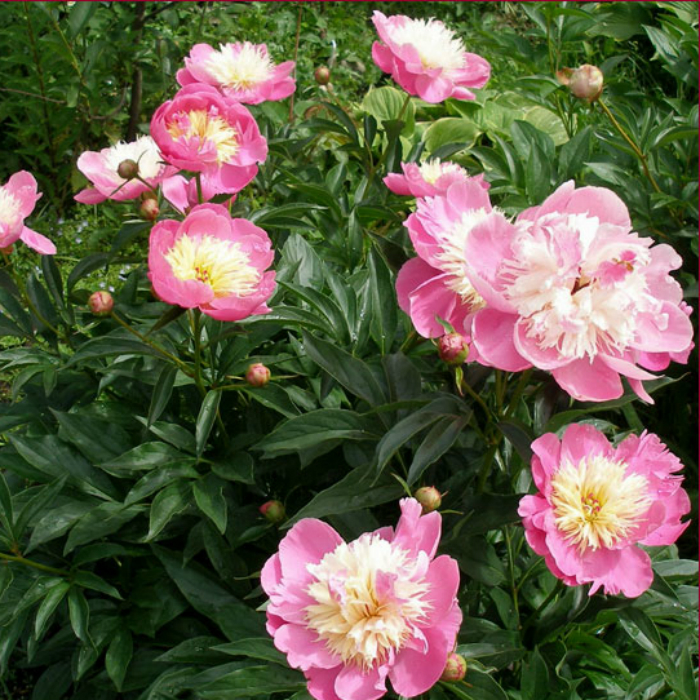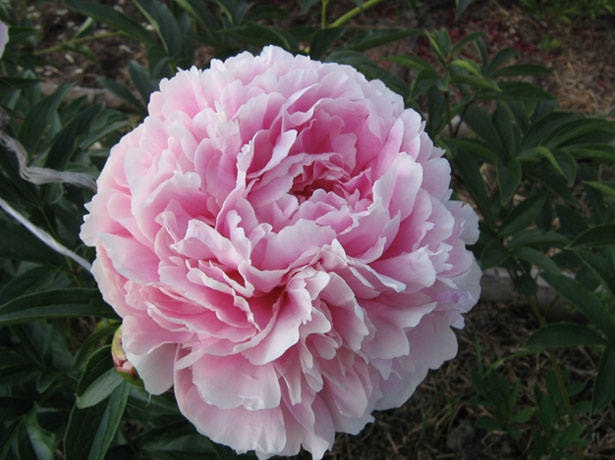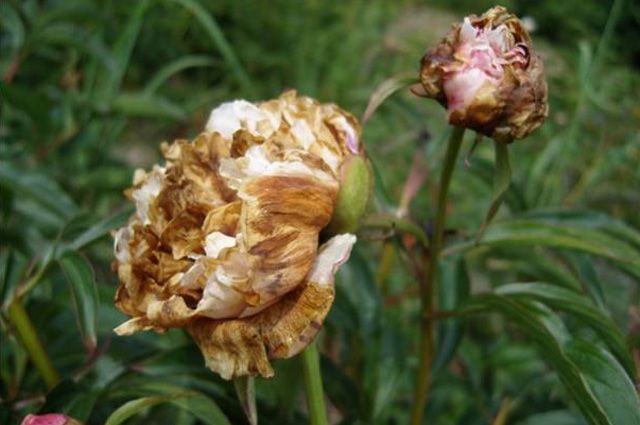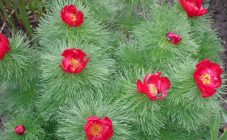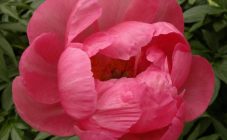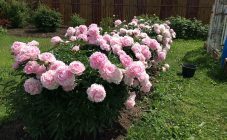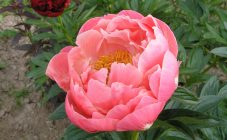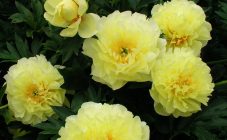Content:
Even novice gardeners are engaged in growing peonies in their plots. Many varieties allow this flower to fit into any landscape design.
Description and herbaceous peony
The native land of the herbaceous peony is China. In Russia, the flower has been cultivated since the beginning of the 18th century. The popularity of peonies is not diminishing due to the large flowers with a strong pleasant aroma and the decorativeness of the whole plant during the season. The foliage of the plant is delicate and looks quite attractive.
The Peony genus includes the herbaceous peony species, planting, caring for and reproducing it is a simple matter. Today there are many varieties endowed with frost resistance and immunity to major diseases. Plants are grown outdoors.
The work of breeders does not stop and more and more beautiful flowers appear. In addition, peonies have a long lifespan, measured in decades.
Plant characteristic
The flower has a powerful rhizome and grows in height within 1 m. There are several stems, leaves of various colors - from light green to dark, reddish shades. The flowers are single, large up to 20 cm, and have a strong aroma. Suitable for cutting.
Characteristics of species and varieties of crops
There are a lot of species. In general, they can be divided into the following groups:
- Not terry - petals are arranged in 1 or 2 rows. The flower is large with many prominent stamens.
- Semi-double - this group of varieties has large flowers with 7 rows of petals, and the stamens are distributed throughout the flower.
- Japanese - stamens are collected in the center of the flower, form a kind of ball. The petals can be in one row or in several.
- Anemoid (mixed type) - the lower petals are wide, arranged in 1-2 rows, and the upper ones are shorter and have a rounded shape. The species was obtained by crossing Japanese and terry peony.
- Terry spherical - many petals form a hemisphere, and when fully opened, a ball.
- Spherical, resembling a crown - the petals form 3 tiers from the bottom of the flower, and on top a ring of semicircular petals is obtained. Usually, the bottom and top are different in shade.
- Resembling a rose - the petals are round, large.
All the variety of varieties can be attributed to any of these groups.
Peony Carol (Carol)
It is a hybrid variety of peony lactic acid. Flowers are about 16 cm in size, double, pink-shaped, have a bright red color. The petals do not fade in the sun, the aroma is weak. The bush is within 90 cm in height, the variety belongs to medium-early, frost-resistant. Support is required because the stems are quite brittle.
Peony Red Grace (Red Grace)
Flower with densely set petals, glossy cherry color. The petals are slightly twisted, they are an even ball. Red Grace blooms early, tolerates winter well.
Peony Primavera (Primavera)
It is a French variety for over 100 years. Large double flowers, up to 18 cm in diameter. The color is unusual - yellow center d edging the petals of pink-cream color. At the end of flowering, the peony becomes almost white.Blooms closer to mid-summer, hardy.
Peony Highlight
Refers to terry hemispherical. The flower reaches a size of 19 cm, it is a rich dark red shade with glossy petals. The stamens are scattered inside the flower. The stems are strong, the leaves are large enough. The height of the bush is about 75 cm. Average flowering time.
Peony Buckeye Bell
The bush reaches 80 cm in height. Semi-double flowers, brown-red color about 18 cm in diameter. The stamens are yellow and centered. The peony of this variety blooms early, it is not picky about care.
Peony Pastelegance
A hybrid of American breeder Bill Seidl. It is considered one of his best works. The main thing in the description of the Pastelegance peony are flowers with a diameter of 22 cm, double, soft peach color. Golden stamens are scattered among the petals. This variety has an average flowering period, a 75 cm high bush, powerful stems, do not need support.
Peony Angel Cheeks (Angel Cheeks)
The height of the stems is 70 cm, they have double pink flowers 18 cm in diameter. There are small red blotches on the central petals. Has a weak aroma.
Peony Mister Ed
It is unique in that one bush contains flowers of various colors - pink, white or half. Refers to early flowering, bush - up to 90 cm with strong stems.
Peony Grassy Iceberg
It has many white buds, in the center the petals are already beige. The plant is crown-shaped, with flowers up to 13 cm in size. Shrub 90 cm high, late flowering.
Herb peony Flock of butterflies
Differs in vigorous growth. Flowers - deep pink, with intense yellow large stamens. The variety is suitable for cutting.
Peony la Belle
The flowers are deep burgundy and have many petals. The bush is medium in height.
Peony herb Solange
The bush is spreading, with many leaves, the stems are strong, up to 70 cm in height, they can hardly bear the weight of the flowers, support is required. Refers to late varieties. The flower is double, 18 cm in diameter, white in color.
Peony Sarah Bernhardt
Flowers - dense semi-double, 20 cm in size, pink (pink).
Features of planting and crop care
The landing site should be well lit, without a large accumulation of moisture. The flower cannot bear shade. It is recommended to grow peonies in one place for no more than 10 years. If the bush has stopped blooming, this is a signal to divide and transplant it. The best time for this procedure is August.
The peony should have 3 to 5 buds. A hole for the plant is dug 50 × 60 cm in size. The soil should be fertile and with the addition of lime. Delenki need to be covered with earth by 3 cm. After planting, the peony is watered abundantly. The distance between the bushes is at least 1 m. It is recommended to remove weeds near the peonies so that the plant receives nutrients in full.
For the first two years, the plant feeds on fertilizers applied during planting, and from the third year it must begin to be fed. Compost is added once a year, ash, superphosphate and potash fertilizers are also needed.
Peonies tolerate winter well, they can do without shelter, but they should be mulched. The stems are left as they are, and the leaves are harvested so that they do not become a source of fungal diseases. Copper sulfate is a good prevention - they need to spray the bushes and the ground nearby.
Major diseases and pests of crops and control measures
Diseases of peonies, as well as of all plants, can be divided into viral and fungal. The source of viral diseases is most often:
- infected planting material;
- garden tools used to treat diseased plants;
- insects - carry viruses from plant to plant.
Major viral diseases:
- circular mosaic of leaves;
- cucumber mosaic;
- narcissus mosaic;
- mottling of a carnation.
Only a specialist can accurately determine the causative agent of the disease. It is necessary to monitor the condition of the leaves and, if spots appear, remove the infected areas by treating the cut with ash.
Fungal diseases of pions arise for the following reasons:
- weather - low temperatures and high humidity;
- excess nitrogen in the soil;
- thickening of plantings and arrangement of plants in the shade;
- clay soils.
Major fungal diseases:
- Gray rot. The fungus survives the winter in the soil, taking advantage of plant debris. It manifests itself in the spring on the lower parts of the stem. It looks like a brown ring. In cold and lingering rains, young buds can also be covered with spots. The mycelium appears as black dots. Fight disease with preparations containing copper, such as Bordeaux liquid.
- Cladosporium. This is a brown spot, the disease quickly spreads to the entire leaf plate. The spots are brown or purple in color, the leaf looks burnt. More common in the southern regions. Bordeaux liquid is also effective against it.
- Septoria. It appears in mid-summer with brown spots. The disease spreads from the lower parts of the plant to the upper ones. The fungus is resistant to low temperatures. The pathogen is destroyed with special drugs - Toksin-M, Tsineb.
- Root rot. The roots and aerial part of the plant are affected. Most often, peonies become infected when dividing a bush. Acidic soil and high humidity are also risk factors. With a small lesion, the diseased parts are removed, with an extensive one, the plant can no longer be saved.
- Verticillary wilting. A serious disease that can lead to the death of the plant. The bush wilts and the symptoms at the beginning are similar to a lack of watering. The affected plant is removed from the site, burned, and the land is treated with formalin or bleach.
As for pests, there are few insects attacking peonies:
- Ants. They come to the plant during the budding period. You can get rid of ants with the help of Iskra and Fufanol.
- May beetles. They feed on the petals and stamens of the plant. The insects are large and can be collected by hand.
- Aphid. Small insects that live in large colonies. They drink the sap of plants, inhibiting their growth. Aphids are washed off with a strong pressure of water, and then the peonies are treated with insecticides.
With prevention and timely treatment, most diseases can be avoided. Peonies are easy enough to grow, and gorgeous flowers will be an excellent reward for your efforts.
